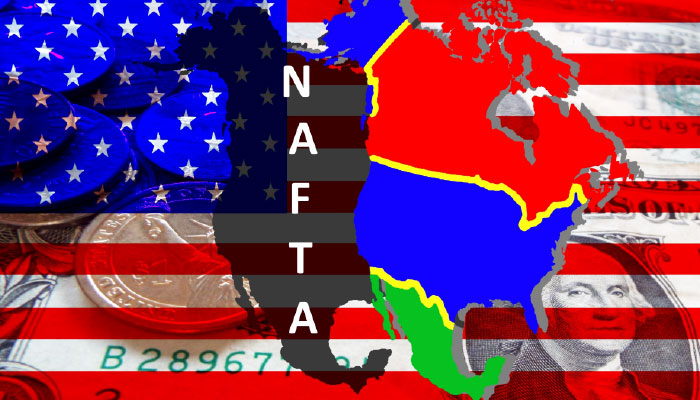Twenty-three years after the original signing of the North American Free Trade Agreement (NAFTA), its three participating countries have come together for renegotiations that haven’t been going all that smoothly, to put it lightly. All parties agree that this treaty, signed before the rise of the internet and digital commerce, needs some serious revisions, but continued disagreements over exactly what those changes should be have caused talks to be extended through March 2018.
Although it’s still too early to tell what the final outcome of the talks will be and how exactly those changes would impact Canadian, Mexican and U.S. companies and economies, what is clear is that certain U.S. demands have caused unease with its neighbors, who had already begun to strengthen ties with other trade partners. At times there has been talk of the United States pulling out of NAFTA, causing confusion. Understanding the costly consequences of pulling out of NAFTA or of possible fall-outs with frustrated neighbors, U.S. companies have begun voicing their opposition to any dramatic changes to the treaty.
‘Everyone Has to Give Up a Little Bit of Candy’
Out of over 100 proposals brought to the table by the United States, here are the top three that are giving Canadian and Mexican negotiators the most concern:
- Scrapping the independent dispute resolution panels outlined in Chapter 19 of NAFTA
- Changing the rule of origin for cars, increasing the percentage of parts originating in the NAFTA region from 62.5 percent to 85 percent, with a requirement for 50 percent to come from the United States
- Adding a sunset clause that would require NAFTA to be renegotiated every five years
Canada has already rejected the idea of eliminating independent dispute resolution panels, calling that proposal a “red line” according to an analyst at The Globe and Mail. Mexico has serious issues with changing the rule of origin for cars and with adding a sunset clause. While both countries realize the benefits NAFTA has brought, including the saving of shipping costs and time, they also argue that the above proposals wouldn’t be good for trade North America. And they aren’t the only ones having come to this conclusion.
U.S. negotiator Robert Lighthizer indicated in a news briefing that “everybody has to give up a little bit of candy, that’s what this is about,” according to Reuters, but U.S. businesses have recently begun giving very contrary opinions. Among companies speaking out against intense changes to NAFTA or a U.S. withdrawal are companies in the U.S. agriculture, apparel and auto industries. Perhaps the most vivid example is from the Driving American Jobs Campaign, which Bloomberg reports will last for four weeks and will seek to highlight how beneficial NAFTA has been for the North American auto trade, and specifically for the United States.
Supply Chains at Stake
If the United States were to pull out of NAFTA, that would cause severe disruption to supply chains that developed over the last 23 years. Businesses have had 23 years to form relationships across borders, and companies have learned how to operate within NAFTA’s provisions. Trade relationships, especially between the United States and Mexico, have become so tightly intertwined that, according to Business Insider UK, economic advisors from Barclays told clients that “separating both manufacturing sectors seems highly costly and as difficult as trying to separate the yolk from a scrambled egg.”
For the automobile sector, parts may cross borders several times before arriving in their final form. Several American companies have factories in Mexico, and apparel companies often produce the fabrics in the United States while outsourcing things like cutting to Mexico, where manufacturing costs are lower. Lower manufacturing costs ultimately bring lower prices to the consumer. Bringing manufacturing back to the United States has always been an option, albeit a much more expensive one. Companies would then have to choose between passing along higher costs to the consumer, or moving manufacturing to other places with lower costs, such as Central America.
Change NAFTA, Change Economies
Mexico and Canada understand how a U.S. withdrawal from NAFTA could affect their economies, and they’ve been hard at work establishing trade relationships with other regions. Just this year, Mexico signed a deal with Brazil for the import of corn, and is discussing trade of cars and ag products with Argentina. With dairy imports from the EU having increased by 122 percent, according to Bloomberg, Mexico may be looking to be less dependent on U.S. imports. Canada also has been strengthening ties with the EU, with The Comprehensive Economic and Trade Agreement (CETA) having gone into provisional effect just last month.
While the outcomes of these relationships remain to be seen, the United States might find itself more isolated from its neighbors if it focuses more on bringing jobs back to America than on maintaining a strong, competitive North American alliance.
Part of the reason why these talks are causing so much unease in the business community is because the state of things is uncharted territory – no former North American leader has threatened to leave NAFTA. Business leaders in the United States recognize that serious changes to NAFTA could:
- Upset decades of supply chains that have built up
- Result in America’s neighbors imposing tariffs on U.S. exports
- Diminish the importance of the United States for Canadian and Mexican exports
- Create a showdown with Congress
- Raise costs which would trickle down to the consumer
Preparing for a New Frontier
NAFTA is comprehensive, spanning several sectors, and any big changes will affect your company and industry in a range of important ways. International trade expert Douglas Cohen discusses how any changes to NAFTA could affect your business in “NAFTA 2.0: Current State of Negotiations and How This Could Affect You (TRD973N)” a webinar with AudioSolutionz. Douglas goes in-depth on what NAFTA is, how Canadian and Mexican objectives compare with those of the United States, and the possibility of Trump leading the United States out of the agreement. He discusses current political realities, negotiation timelines, and what U.S. businesses can look for as the talks continue.




